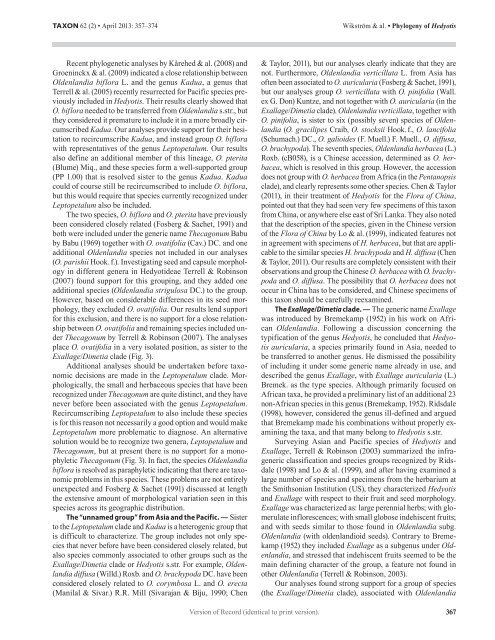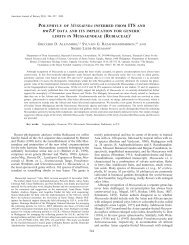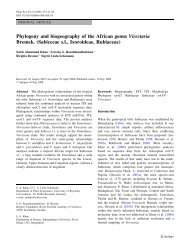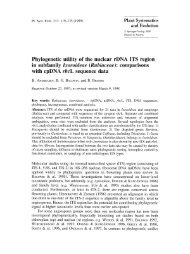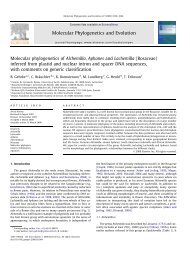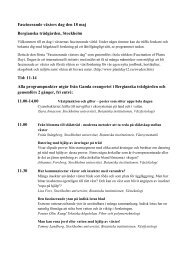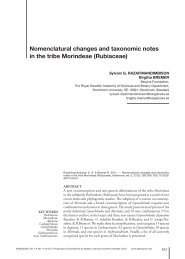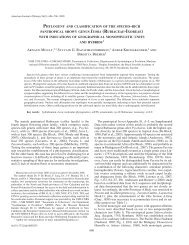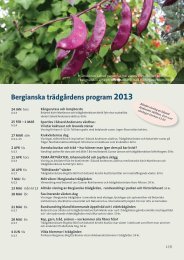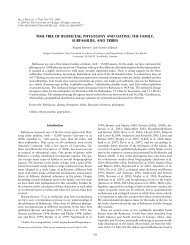Phylogeny of Hedyotis L. (Rubiaceae: Spermacoceae): Redefining a ...
Phylogeny of Hedyotis L. (Rubiaceae: Spermacoceae): Redefining a ...
Phylogeny of Hedyotis L. (Rubiaceae: Spermacoceae): Redefining a ...
Create successful ePaper yourself
Turn your PDF publications into a flip-book with our unique Google optimized e-Paper software.
TAXON 62 (2) • April 2013: 357–374Wikström & al. • <strong>Phylogeny</strong> <strong>of</strong> <strong>Hedyotis</strong>Recent phylogenetic analyses by Kårehed & al. (2008) andGroeninckx & al. (2009) indicated a close relationship betweenOldenlandia biflora L. and the genus Kadua, a genus thatTerrell & al. (2005) recently resurrected for Pacific species previouslyincluded in <strong>Hedyotis</strong>. Their results clearly showed thatO. biflora needed to be transferred from Oldenlandia s.str., butthey considered it premature to include it in a more broadly circumscribedKadua. Our analyses provide support for their hesitationto recircumscribe Kadua, and instead group O. biflorawith representatives <strong>of</strong> the genus Leptopetalum. Our resultsalso define an additional member <strong>of</strong> this lineage, O. pterita(Blume) Miq., and these species form a well-supported group(PP 1.00) that is resolved sister to the genus Kadua. Kaduacould <strong>of</strong> course still be recircumscribed to include O. biflora,but this would require that species currently recognized underLeptopetalum also be included.The two species, O. biflora and O. pterita have previouslybeen considered closely related (Fosberg & Sachet, 1991) andboth were included under the generic name Thecagonum Babuby Babu (1969) together with O. ovatifolia (Cav.) DC. and oneadditional Oldenlandia species not included in our analyses(O. parishii Hook. f.). Investigating seed and capsule morphologyin different genera in Hedyotideae Terrell & Robinson(2007) found support for this grouping, and they added oneadditional species (Oldenlandia strigulosa DC.) to the group.However, based on considerable differences in its seed morphology,they excluded O. ovatifolia. Our results lend supportfor this exclusion, and there is no support for a close relationshipbetween O. ovatifolia and remaining species included underThecagonum by Terrell & Robinson (2007). The analysesplace O. ovatifolia in a very isolated position, as sister to theExallage/Dimetia clade (Fig. 3).Additional analyses should be undertaken before taxonomicdecisions are made in the Leptopetalum clade. Morphologically,the small and herbaceous species that have beenrecognized under Thecagonum are quite distinct, and they havenever before been associated with the genus Leptopetalum.Recircumscribing Leptopetalum to also include these speciesis for this reason not necessarily a good option and would makeLeptopetalum more problematic to diagnose. An alternativesolution would be to recognize two genera, Leptopetalum andThecagonum, but at present there is no support for a monophyleticThecagonum (Fig. 3). In fact, the species Oldenlandiabiflora is resolved as paraphyletic indicating that there are taxonomicproblems in this species. These problems are not entirelyunexpected and Fosberg & Sachet (1991) discussed at lengththe extensive amount <strong>of</strong> morphological variation seen in thisspecies across its geographic distribution.The “unnamed group” from Asia and the Pacific. — Sisterto the Leptopetalum clade and Kadua is a heterogenic group thatis difficult to characterize. The group includes not only speciesthat never before have been considered closely related, butalso species commonly associated to other groups such as theExallage/Dimetia clade or <strong>Hedyotis</strong> s.str. For example, Oldenlandiadiffusa (Willd.) Roxb. and O. brachypoda DC. have beenconsidered closely related to O. corymbosa L. and O. erecta(Manilal & Sivar.) R.R. Mill (Sivarajan & Biju, 1990; Chen& Taylor, 2011), but our analyses clearly indicate that they arenot. Furthermore, Oldenlandia verticillata L. from Asia has<strong>of</strong>ten been associated to O. auricularia (Fosberg & Sachet, 1991),but our analyses group O. verticillata with O. pinifolia (Wall.ex G. Don) Kuntze, and not together with O. auricularia (in theExallage/Dimetia clade). Oldenlandia verticillata, together withO. pinifolia, is sister to six (possibly seven) species <strong>of</strong> Oldenlandia(O. gracilipes Craib, O. stocksii Hook. f., O. lancifolia(Schumach.) DC., O. galioides (F. Muell.) F. Muell., O. diffusa,O. brachypoda). The seventh species, Oldenlandia herbacea (L.)Roxb. (cB058), is a Chinese accession, determined as O. herbacea,which is resolved in this group. However, the accessiondoes not group with O. herbacea from Africa (in the Pentanopsisclade), and clearly represents some other species. Chen & Taylor(2011), in their treatment <strong>of</strong> <strong>Hedyotis</strong> for the Flora <strong>of</strong> China,pointed out that they had seen very few specimens <strong>of</strong> this taxonfrom China, or anywhere else east <strong>of</strong> Sri Lanka. They also notedthat the description <strong>of</strong> the species, given in the Chinese version<strong>of</strong> the Flora <strong>of</strong> China by Lo & al. (1999), indicated features notin agreement with specimens <strong>of</strong> H. herbacea, but that are applicableto the similar species H. brachypoda and H. diffusa (Chen& Taylor, 2011). Our results are completely consistent with theirobservations and group the Chinese O. herbacea with O. brachypodaand O. diffusa. The possibility that O. herbacea does notoccur in China has to be considered, and Chinese specimens <strong>of</strong>this taxon should be carefully reexamined.The Exallage/Dimetia clade. — The generic name Exallagewas introduced by Bremekamp (1952) in his work on AfricanOldenlandia. Following a discussion concerning thetypification <strong>of</strong> the genus <strong>Hedyotis</strong>, he concluded that <strong>Hedyotis</strong>auricularia, a species primarily found in Asia, needed tobe transferred to another genus. He dismissed the possibility<strong>of</strong> including it under some generic name already in use, anddescribed the genus Exallage, with Exallage auricularia (L.)Bremek. as the type species. Although primarily focused onAfrican taxa, he provided a preliminary list <strong>of</strong> an additional 23non-African species in this genus (Bremekamp, 1952). Ridsdale(1998), however, considered the genus ill-defined and arguedthat Bremekamp made his combinations without properly examiningthe taxa, and that many belong to <strong>Hedyotis</strong> s.str.Surveying Asian and Pacific species <strong>of</strong> <strong>Hedyotis</strong> andExallage, Terrell & Robinson (2003) summarized the infragenericclassification and species groups recognized by Ridsdale(1998) and Lo & al. (1999), and after having examined alarge number <strong>of</strong> species and specimens from the herbarium atthe Smithsonian Institution (US), they characterized <strong>Hedyotis</strong>and Exallage with respect to their fruit and seed morphology.Exallage was characterized as: large perennial herbs; with glomerulateinflorescences; with small globose indehiscent fruits;and with seeds similar to those found in Oldenlandia subg.Oldenlandia (with oldenlandioid seeds). Contrary to Bremekamp(1952) they included Exallage as a subgenus under Oldenlandia,and stressed that indehiscent fruits seemed to be themain defining character <strong>of</strong> the group, a feature not found inother Oldenlandia (Terrell & Robinson, 2003).Our analyses found strong support for a group <strong>of</strong> species(the Exallage/Dimetia clade), associated with OldenlandiaVersion <strong>of</strong> Record (identical to print version).367


